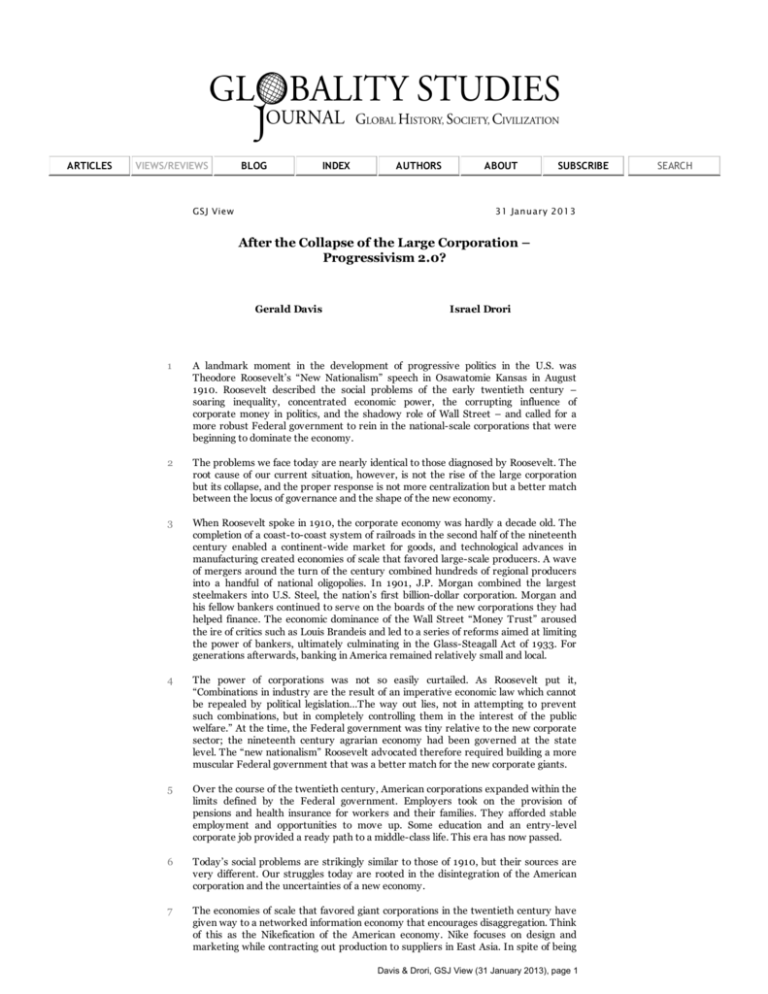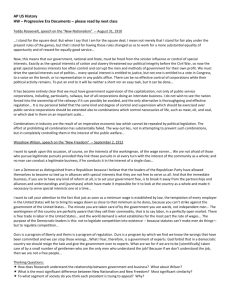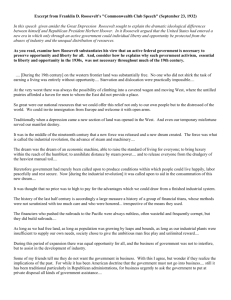After the Collapse of the Large Corporation
advertisement

ARTICLES VIEWS/REVIEWS BLOG GS J View INDEX AUTHORS ABOUT SUBSCRIBE 31 January 2013 After the Collapse of the Large Corporation – Progressivism 2.0? Gerald Davis Israel Drori 1 A landmark moment in the development of progressive politics in the U.S. was Theodore Roosevelt’s “New Nationalism” speech in Osawatomie Kansas in August 1910. Roosevelt described the social problems of the early twentieth century – soaring inequality, concentrated economic power, the corrupting influence of corporate money in politics, and the shadowy role of Wall Street – and called for a more robust Federal government to rein in the national-scale corporations that were beginning to dominate the economy. 2 The problems we face today are nearly identical to those diagnosed by Roosevelt. The root cause of our current situation, however, is not the rise of the large corporation but its collapse, and the proper response is not more centralization but a better match between the locus of governance and the shape of the new economy. 3 When Roosevelt spoke in 1910, the corporate economy was hardly a decade old. The completion of a coast-to-coast system of railroads in the second half of the nineteenth century enabled a continent-wide market for goods, and technological advances in manufacturing created economies of scale that favored large-scale producers. A wave of mergers around the turn of the century combined hundreds of regional producers into a handful of national oligopolies. In 1901, J.P. Morgan combined the largest steelmakers into U.S. Steel, the nation’s first billion-dollar corporation. Morgan and his fellow bankers continued to serve on the boards of the new corporations they had helped finance. The economic dominance of the Wall Street “Money Trust” aroused the ire of critics such as Louis Brandeis and led to a series of reforms aimed at limiting the power of bankers, ultimately culminating in the Glass-Steagall Act of 1933. For generations afterwards, banking in America remained relatively small and local. 4 The power of corporations was not so easily curtailed. As Roosevelt put it, “Combinations in industry are the result of an imperative economic law which cannot be repealed by political legislation…The way out lies, not in attempting to prevent such combinations, but in completely controlling them in the interest of the public welfare.” At the time, the Federal government was tiny relative to the new corporate sector; the nineteenth century agrarian economy had been governed at the state level. The “new nationalism” Roosevelt advocated therefore required building a more muscular Federal government that was a better match for the new corporate giants. 5 Over the course of the twentieth century, American corporations expanded within the limits defined by the Federal government. Employers took on the provision of pensions and health insurance for workers and their families. They afforded stable employment and opportunities to move up. Some education and an entry-level corporate job provided a ready path to a middle-class life. This era has now passed. 6 Today’s social problems are strikingly similar to those of 1910, but their sources are very different. Our struggles today are rooted in the disintegration of the American corporation and the uncertainties of a new economy. 7 The economies of scale that favored giant corporations in the twentieth century have given way to a networked information economy that encourages disaggregation. Think of this as the Nikefication of the American economy. Nike focuses on design and marketing while contracting out production to suppliers in East Asia. In spite of being Davis & Drori, GSJ View (31 January 2013), page 1 SEARCH the world’s largest sporting goods company by far, Nike has only 38,000 employees around the world – less than the number GM hired in 1941 alone. The Nike model has spread widely in sectors from clothing to consumer electronics to pet food to pharmaceuticals; meanwhile, the largest employers in the U.S. are overwhelmingly in retail, where wages, benefits, and opportunities for advancement are modest at best. 8 Nikefication greatly reduces the advantages of massive corporate scale, allowing new entrants to grow (and collapse) rapidly with relatively few employees. The bestselling U.S. television brand last year was not Sony or Samsung but Vizio, located in Irvine, California. Vizio outsources production and distribution, much like Nike, and has introduced scores of new high-tech products – all with fewer than 200 employees. Even the ubiquitous Facebook has only 4000 employees. Small-scale local production has also seen a renaissance. Thanks to cheap production technology and the Web, local producers have entered dozens of industries formerly dominated by national giants, from microbrewing to rooftop farming. Small is the new big. 9 The fear with companies like Vizio, or similar firms in other industries, is not that they are too powerful, but that they are too weak, that is, that they are too ephemeral to carry out the policies that we expect of corporations. Why should a temporary company be expected to provide health insurance or pensions to workers who will outlive them by decades? And who can expect a 200‑employee company to provide long-term careers or job ladders? 10 The problem is bigger than we realize. Turnover in the so-called blue chips has never been higher: while most companies in the Dow of 1930 were still there sixty years later, only three are left today: two oil companies and GE. The U.S. had fewer than half as many public corporations in 2012 as it did in 1997, and the number declined every year but one since 2000. Even Wall Street firms are not invincible: of the five major independent investment banks in early 2008, only two are left. 11 The old corporate system is no longer meeting society’s needs for employment and benefits. It has also turned up short for investors and retirees: real returns for the first decade of the twenty-first century were worse than any decade in U.S. history, and the S&P 500 index is still roughly where it was in early 2000. 12 These are not problems that a central government can solve by prodding corporations to do more, as in past generations. It would take more than 3000 Facebooks to employ all of the jobless people in the U.S. today. Even if U.S.-based multinationals were to bring all of their work back to the U.S., it would be done in high-tech facilities with relatively few workers – not out of malice, but due to Roosevelt’s “imperative economic laws.” With corporations no longer equipped to provide middle-class employment, benefits, and career mobility on a national scale, the current economy is like an inscrutable game of chutes and ladders, lifting a few kids from their dorm rooms to the economic stratosphere while millions of others drop unexpectedly into long-term unemployment. 13 The tools of governance suited to a U.S. Steel economy are not those suited to a Facebook economy. Just as national defense had to adjust to a world in which security threats are more likely to come from non-state actors than from other nation-states, our approach to economic security needs to adjust to a post-corporate economy. 14 What is the progressive response? When President Obama visited Osawatomie in December 2011 to update Roosevelt’s agenda, Obama’s prescriptions – affordable higher education, worker training, improved infrastructure, financial reform – were laudable but generic fixes, equally applicable to Egypt or Thailand. But they will do little to address inequality and concentrated power in the U.S. Obama is correct that America’s strength is its ability to innovate, in both technologies and economic models. But the new innovative technologies favor a kind of cosmopolitan localism. In a Webbased economy, there are opportunities for small- and medium-sized local businesses with global access. And it is likely to be local innovators, not big corporations, who will be in the vanguard. 15 The economic strains we face today cannot be addressed either by a quixotic return to states’ rights, as proposed by the Tea Party right, nor by more centralized governance, as proposed by paleo-progressives, but by strengthened local economies organized along principles that fit with the new shape of our coming post-corporate economy. There are hints of such models in post-industrial cities, like the Evergreen Cooperative system in Cleveland, but what is needed now is a more thorough assessment of the economic underpinnings of a new progressivism. Unlike the twentieth century version, which favored centralized solutions, progressivism 2.0 could mark the emergence of a more democratic and cosmopolitan localism. [PDF] Davis & Drori, GSJ View (31 January 2013), page 2 Note Davis’ latest book, Managed by the Markets: How Finance Re-Shaped America, documents the influence of financial markets on American corporations and society. Drori’s forthcoming book Genealogical Evolution of Israeli High Tech (Stanford University Press) analyzes the rise of Israel’s entrepreneurial economy. Copyright © GSJ & Author(s). ISSN 1557-0266 GSJ is published at Stony Brook University by the Stony Brook Institute for Global Studies (SBIGS) Davis & Drori, GSJ View (31 January 2013), page 3







